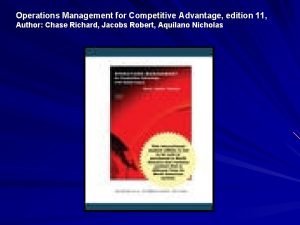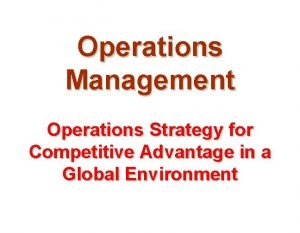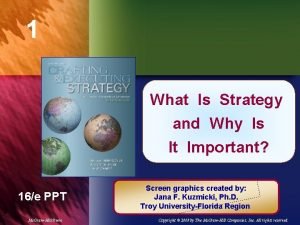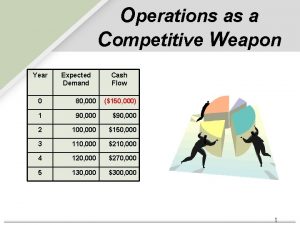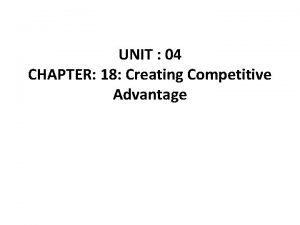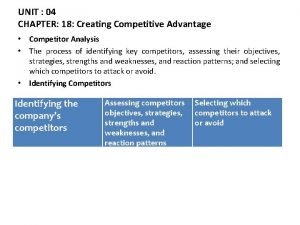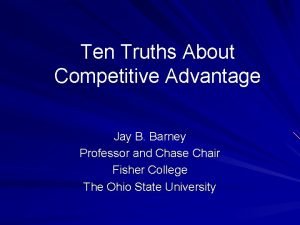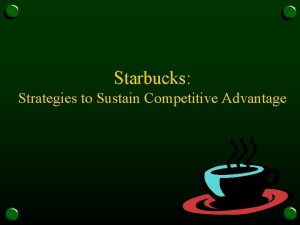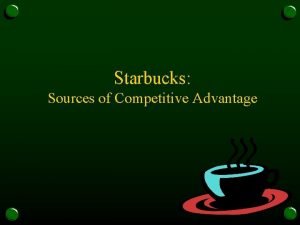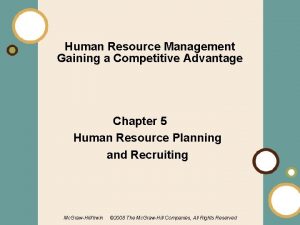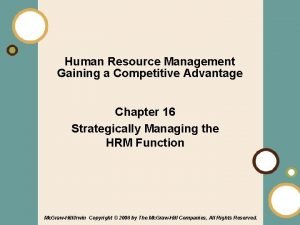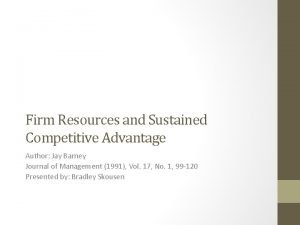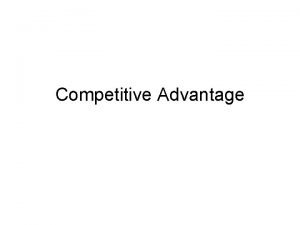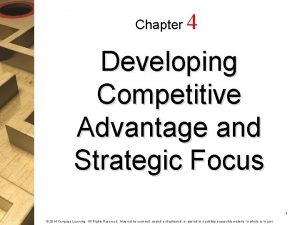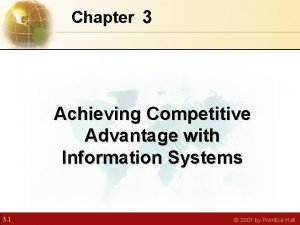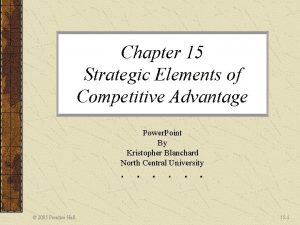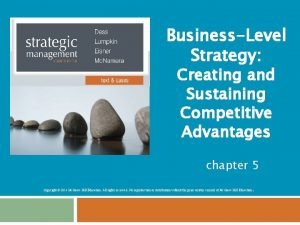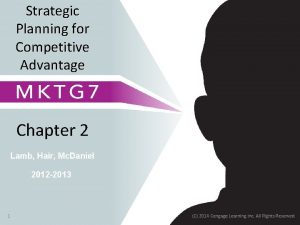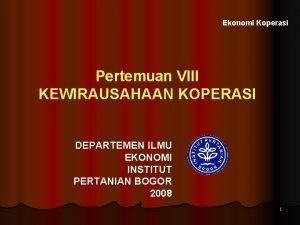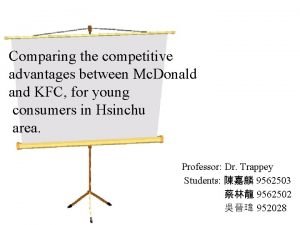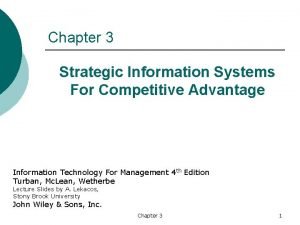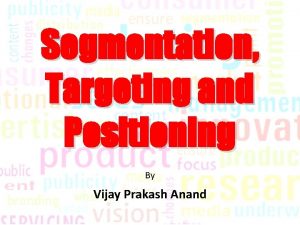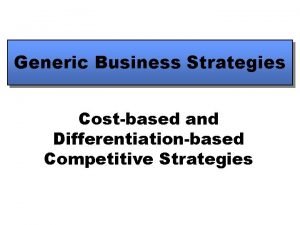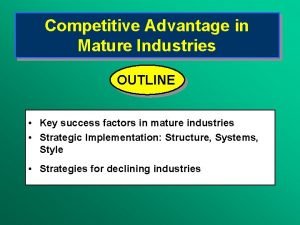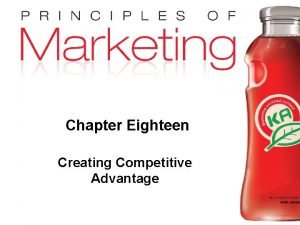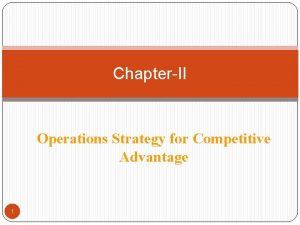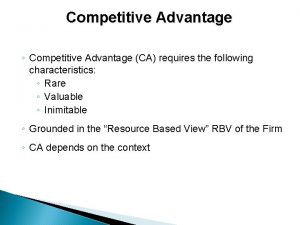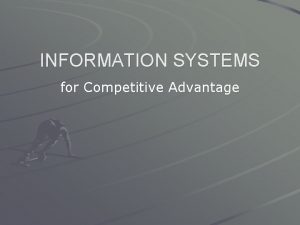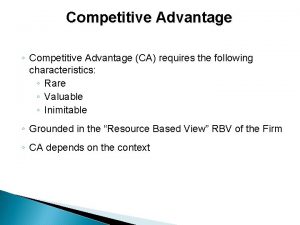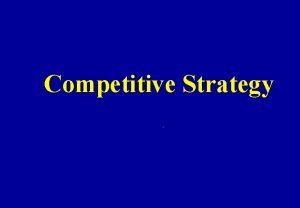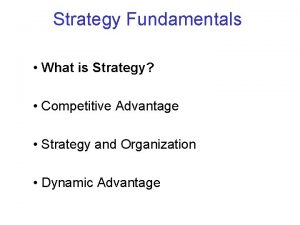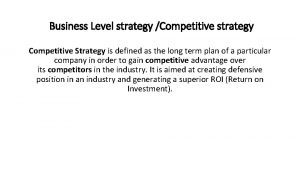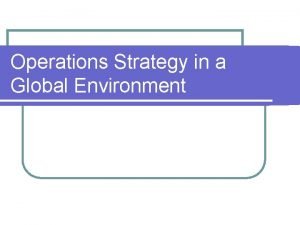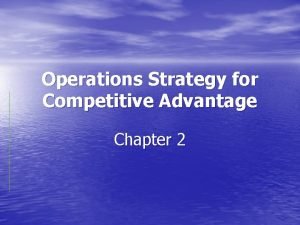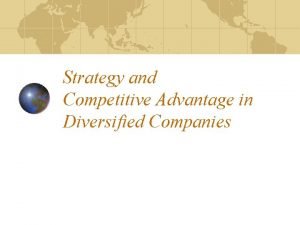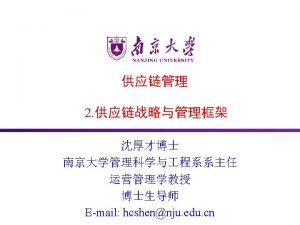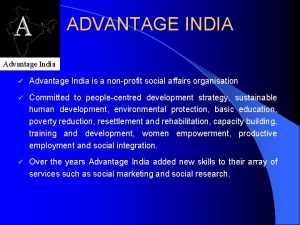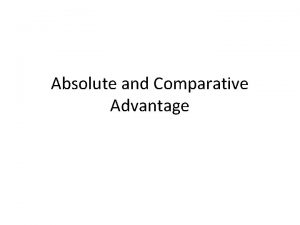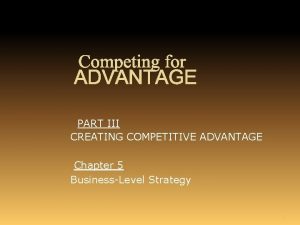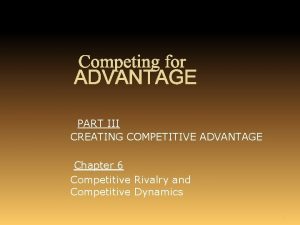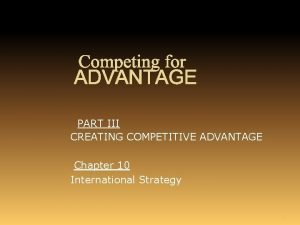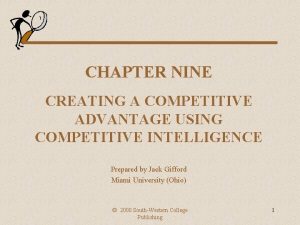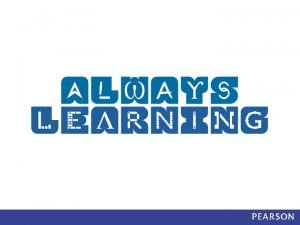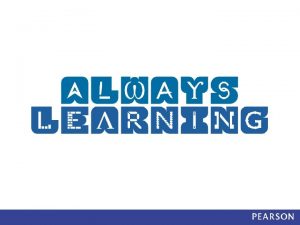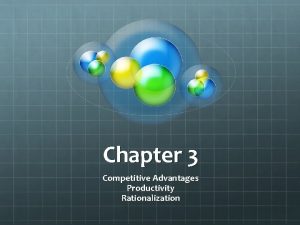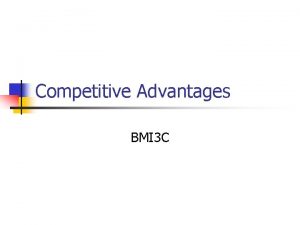ChapterII Operations Strategy for Competitive Advantage 1 Introduction


































- Slides: 34

Chapter-II Operations Strategy for Competitive Advantage 1

Introduction Business organizations craft their strategies in light of the prevailing environmental realities. Before conducting the SWOT analysis, however, they have to really know what their strategic intents are (mission, vision, and objectives). The reason why they first scan the environmental variables and then define their strategic intents is to craft an appropriate strategy; a strategy that can help them realize the strategic intents given the environmental constraints and opportunities. 2

Defining the Strategic Intents and Strategies Mission The mission states why a firm exists. Mission statements provide boundaries and focus for organizations and the concept around which the firm can rely. It also clarifies and inculcates one with the nature of a business an organization runs, the type of products it produces, and the needs it fills. 3

Mission cont… Once an organization’s mission has been decided, each functional area within the firm determines its supporting mission. Visioning is visualizing things in mind and this is one of the most important things in one’s life. Objectives Business mission and company directions have to be defined in terms of performance standards, something by which the business’s progress can be measured, evaluated and rated. 4

Objectives cont… Objectives can be: a) Short-term b) Medium-term and c) Long-term Or Financial and Business objectives measure how the business performs relative to its rivals and include: Leadership in technology Overtaking rivals’ customers Joining to foreign markets Improving quality Delivering better post-sales services a) b) 5

Strategy Thamson and Strickland define strategy as a pattern of actions and business approaches managers employ to please customers, build attractive market position, and achieve organizational objectives. A company‘s actual strategy is partly planned and partly reactive to changing situations. Intended Strategy Realized Strategy Unrealized strategy 6 Actual Strategy gy Emer ate r t s t n ge

Cont… If you think of goals as destinations, then strategies are the road maps for reaching the destinations. Strategies provide focus for decision-making. organizations have overall strategies called organization strategies. The functional strategies should support the overall strategies of the organization. 7

Strategies for Competitive Advantage Differentiation – better, or at least different 2. Cost leadership – cheaper 3. Response – more responsive 1. 8

Competing on Differentiation Uniqueness can go beyond both the physical characteristics and service attributes to encompass everything that impacts customer’s perception of value 9

Competing on Cost Provide the maximum value as perceived by customer. Does not imply low quality. ► ► ► 10 Southwest Airlines – secondary airports, no frills service, efficient utilization of equipment Walmart – small overhead, shrinkage, and distribution costs Franz Colruyt – no bags, no bright lights, no music, and doors on freezers

Competing on Response ▶ Flexibility is matching market changes in design innovation and volumes ▶ A way of life at Hewlett-Packard ▶ Reliability is meeting schedules ▶ German machine industry ▶ Timeliness is quickness in design, production, and delivery ▶ Johnson Electric, Pizza Hut, Motorola 11

Environmental Analysis Business decisions, especially the strategic ones need a clear identification of relevant variables. detailed an in-depth analysis of the relevant variables to understand their impact and implication for the operations function in particular and the organization at large have to be made. The environment to analyze can be broken down into two: . 12

1. External Environment The external environment is further divided into two sub external environments: a. Macroenvironment The factors include: i. Political and Legal Taxation policy Employment law Foreign trade regulation Monopolies legislation 13

Cont… ii. Economic Factors Gross domestic product Disposable income Unemployment Exchange rate fluctuations Interest rate 14

Cont… iii. Socio-Cultural Factors Demographic variables Income distribution Social mobility Attitude to work and leisure 15

Cont… iv. Environmental Factors Energy consumption Environmental Protection Availability of infrastructural facilities v. Technological Factors Technology transfer Pace of technological change 16

b. Industry Analysis Porter’s five competitive forces are: The competitive pressure among the existing rivals Threats from new entrants Threats from substitute products Threats from bargaining power of suppliers Threats from bargaining power of customers 17

Operations Strategy Model: Levels at which a Strategy Operates 18

Cont… Corporate strategy defines what businesses the company is pursuing. Business strategy follows from the corporate strategy and defines how a particular business will compete. Most large corporations have several different businesses each competing in different market segments. Each business has to develop a strategy that states how it will compete in the market which it sells its products to. Operations strategy, a functional strategy, is a statement of how operations function will contribute to the achievement of corporate goals. 19

Cont… It is, therefore, narrower and much more specific in scope than its corresponding business strategy and corporate in that it addresses the following specific questions: What products can be produced in which facility and how much? Which products are going to be produced internally, and which ones will be purchased? What level of technology (automation, etc) will be used? Are the resources going to be owned or bought? 20

Cont… How will the products be distributed to the end customer? Where will the facilities be located, with how much capacity? What type of processes will be utilized to produce products? How much flexibility is required from each process and each product? Which suppliers will provide materials, and how much? What kind of human skills are needed? 21

Cont… Firms’ operations achieve missions in three conceptual ways: (1) differentiation, (2) cost leadership, and (3) quick response. In practice, these three concepts- differentiation, low cost, and response-are often translated into six specific strategies: flexibility in design and volume low price delivery quality after-sale service, and a broad product line (typical Operations Objectives) 22

Focused Operations Lack of focus in manufacturing plants and service operations results from excessive attention to economies of scale. In the name of efficiency due to economies of scale, different missions are being served by the same operation. The solution is to arrange each product as a plant-within-aplant (PWP). PWP may, however, sacrifice some economies of scale while doing a better job of meeting market requirements and improving profitability. . 23

Cont. . . 24

After focusing the operations based on the volume of. the products, it is put as: 25

Cont… Several types of focus dimensions need to be considered. These include the following: Product focus Process type focus Volume of sales focus Make-to-order and make-to-stock New product vs old product focus 26

Order qualifiers and order winner Order qualifiers: Characteristics of a company’s product or service that customers percieve as minimum standards of acceptability to be considered as a standard Order winners: Characteristics of a company’s product or service that cause it to be perceived as better than the competition 27

Discussion questions How operation strategy influence other strategies of given organization. Explain its role and importance Operations strategy: 2. What is meant by the terms order qualifiers and order winners? Explain why they are important. 3. Explain what is meant by the term competitive priority and describe the four categories of competitive priorities discussed in the chapter. 1. 28

Discussion questions 4. Explain the role of operations strategy in a business. 5. Describe how an operations strategy is formulated from the business strategy. 6. Find an example of a company that makes quality its competitive priority. Find another company that makes time its competitive priority. Compare these strategies 29

Discussion questions 30 1. Identify how changes in the external environment may affect the OM strategy for a company. For example, what impact are the following factors likely to have on OM strategy? a. The occurrence of a major storm or hurricane or COVID 19. b. The much discussed decrease in the quality of Ethiopian primary and secondary school systems. c. Trade Legislation such as WTO and NAFTA and changes in tariffs and quotas. d. The rapid rate at which the cost of health insurance is increasing.

Discussion questions Identify how the changes in the internal environment affect the OM strategy for a company. For example, what impact are the following factors likely to have on OM strategy? a. The increased use of Local and Wide Area Networks (LANs and WANs) b. An increased emphasis on service c. The increased role of women in the workplace d. The seemingly increasing rate at which both internal and external environments change. 31

Discussion questions Operations managers are called upon to support the organization's strategy. OM does this with some combination of one of three strategies. What are these three strategies? 32

Case Analysis Duke’s Business Plan As the business team sits at their round conference table, Rita brings up an issue now near to her heart. She has just become engaged to Duke, who works for Pepsi Co. Duke is worried about his new job. Coke’s CEO Robert Goizueta has created more wealth for shareholders than any CEO in history with the single focused strategy of making Coke the domestic and international drink. On the other hand, Pepsi is a conglomerate with domestic and international drinks; restaurants such as Sonargaon, Sheraton, Sundarban, and Pizza Hut etc; Bottling operations. 33

Cont--- While Coke has been focused on selling Coke, Pepsi 34 has diversified, pouring billions of dollars into other capital-intensive business. Some think Pepsi has lost the cola wars, both in Bangladesh and overseas. Duke wants the team’s advise about what strategic help he can give his new boss. Questions: 1. Taking the steps in the strategic process in order, what advice do you think the team should give Duke? 2. What factor do you think have led Pepsi to choose its strategy instead of Coke’s strategy? 3. What strategic planning changes would you recommend to Pepsi and why?
 Operations management for competitive advantage
Operations management for competitive advantage Operations management for competitive advantage
Operations management for competitive advantage A company strategy and its quest for competitive advantage
A company strategy and its quest for competitive advantage Operations strategy as a competitive weapon
Operations strategy as a competitive weapon Chapter 2 operations strategy and competitiveness
Chapter 2 operations strategy and competitiveness Least competitive market
Least competitive market Pharmacology introduction
Pharmacology introduction Standard cycle market example
Standard cycle market example Value creation strategy
Value creation strategy Competitor centered company
Competitor centered company Jay b barney
Jay b barney Generic strategy of starbucks
Generic strategy of starbucks What is starbucks competitive advantage
What is starbucks competitive advantage Human resource management gaining a competitive advantage
Human resource management gaining a competitive advantage Human resource management gaining a competitive advantage
Human resource management gaining a competitive advantage Human resource management gaining a competitive advantage
Human resource management gaining a competitive advantage Levis competitive advantage
Levis competitive advantage Barney 1991 firm resources
Barney 1991 firm resources Quotes on competitive advantage
Quotes on competitive advantage Bases of competitive advantage
Bases of competitive advantage Generic building blocks of competitive advantage
Generic building blocks of competitive advantage Developing competitive advantage and strategic focus
Developing competitive advantage and strategic focus Achieving competitive advantage with information systems
Achieving competitive advantage with information systems Searching for loose bricks
Searching for loose bricks Creating and sustaining competitive advantage
Creating and sustaining competitive advantage Mis competitive advantage
Mis competitive advantage Strategic planning for competitive advantage
Strategic planning for competitive advantage Competitive advantage pada koperasi
Competitive advantage pada koperasi Disadvantages of kfc
Disadvantages of kfc Strategic information system advantages and disadvantages
Strategic information system advantages and disadvantages Chapter 2 strategic planning for competitive advantage
Chapter 2 strategic planning for competitive advantage Segmentation targeting positioning of amul
Segmentation targeting positioning of amul A differentiation-based competitive advantage
A differentiation-based competitive advantage Competitive advantage in mature industries
Competitive advantage in mature industries Chapter 18 creating competitive advantage
Chapter 18 creating competitive advantage
